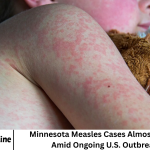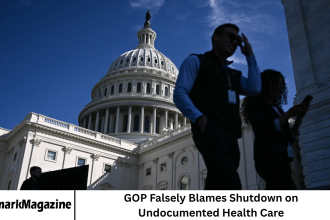A new report highlights how California’s coordinated partnerships between state agencies, community organizations, and healthcare providers significantly improved the state’s COVID-19 response and advanced health equity during one of the most challenging public health crises in modern history.
The findings underscore the crucial role that collaboration played in reaching marginalized communities, increasing vaccination rates, and reducing disparities in healthcare access. California, often seen as a testing ground for large-scale policy innovation, once again demonstrated that inclusive governance and community engagement can yield life-saving outcomes.
From mobile vaccination units in rural areas to multilingual public awareness campaigns in immigrant communities, the state’s multifaceted approach offered a blueprint for how public health systems can evolve to meet the needs of diverse populations during emergencies.
More Read: GOP Falsely Blames Shutdown on Undocumented Health Care
A Look Back at California’s COVID-19 Response
When the COVID-19 pandemic hit in early 2020, California was one of the first U.S. states to implement strict lockdowns and public health measures. While those steps helped slow transmission, they also exposed deep-rooted inequalities in healthcare, housing, and economic stability.
Many low-income, Black, Latino, and Indigenous communities faced higher infection and mortality rates due to systemic barriers in healthcare access and employment conditions. Recognizing these disparities, state officials and public health leaders moved quickly to form partnerships that could reach those most at risk.
The California Department of Public Health (CDPH), the Office of Health Equity, and the California Health and Human Services Agency (CalHHS) collaborated with local nonprofits, faith-based organizations, and county health departments to tailor outreach and resources to vulnerable populations.
This coordinated effort became a defining feature of the state’s response—an acknowledgment that equity must be central to public health strategy, not an afterthought.
The Partnership Model: A Statewide Collaboration
The report, commissioned by CalHHS and authored by a team of independent health policy experts, outlines how California’s “Public Health Equity Partnership” model worked in practice. The partnership brought together over 200 organizations spanning public, private, and community sectors.
Key components of this model included:
- Community-Based Outreach: Local organizations served as trusted messengers to counter misinformation and encourage testing and vaccination, particularly in areas where government trust was historically low.
- Data Sharing and Transparency: The state invested in better data infrastructure to track COVID-19 outcomes by race, ethnicity, ZIP code, and income level. This data-driven approach allowed for targeted interventions.
- Culturally Responsive Messaging: California prioritized multilingual communication strategies—broadcasting messages in Spanish, Tagalog, Mandarin, Vietnamese, and other languages—to ensure no community was left behind.
- Mobile and Pop-Up Clinics: Thousands of mobile units were deployed to reach residents without access to transportation or health facilities.
- Workplace and Housing Protections: Partnerships with labor groups and housing advocates ensured that workers in essential industries received PPE, testing, and paid leave protections.
Together, these initiatives helped bridge critical gaps in healthcare access and built long-term trust between public institutions and communities.
Impact on Health Equity
The impact of these efforts was measurable. According to the report, California achieved some of the highest vaccination rates in the nation among historically underserved groups. By late 2022:
- Latino vaccination rates had climbed to nearly 80%, closing an early gap seen in 2021.
- Black Californians reached over 70% vaccination coverage, a major improvement over initial rollout disparities.
The state’s overall hospitalization and death rates fell faster than the national average, largely due to focused interventions in high-risk ZIP codes. Additionally, the partnership model contributed to broader health equity outcomes beyond COVID-19.
Community health organizations strengthened their infrastructure, improving access to care for chronic conditions, mental health services, and preventive screenings. Dr. Tomás Aragón, California’s Public Health Director, emphasized that “the partnerships built during COVID-19 didn’t just save lives—they reshaped how we think about equitable healthcare delivery in this state.”
Challenges and Lessons Learned
Despite the successes, the report also acknowledges key challenges. Coordination among hundreds of agencies and organizations was often complex, leading to delays and administrative bottlenecks. Smaller nonprofits sometimes struggled with funding stability and data-sharing requirements.
Another major hurdle was combating misinformation and vaccine hesitancy. Social media platforms became battlegrounds for false claims, and many community health workers found themselves fighting an “infodemic” alongside the pandemic itself.
The report’s authors stress that while California made significant progress, maintaining these equity gains will require continuous investment and policy support. “Equity isn’t achieved through crisis alone,” one analyst noted. “It demands sustained commitment, accountability, and resources even in times of stability.”
Funding and Policy Support
The state’s success was bolstered by strong fiscal support. Between 2020 and 2023, California allocated over $4 billion toward its COVID-19 public health response, with nearly $600 million directed specifically toward equity-focused programs.
These funds supported initiatives such as:
- The Community Health Worker (CHW) Initiative, which trained and deployed over 5,000 workers across the state.
- The Health Equity Data Dashboard, which provided real-time updates on pandemic outcomes and resource distribution.
- Grants for local public health departments to partner with ethnic media outlets and trusted community influencers.
Governor Gavin Newsom’s administration has pledged to continue funding health equity initiatives under the state’s “California for All” framework. Legislators are currently debating proposals to institutionalize some of these partnership models into long-term public health policy.
Voices from the Community
The heart of California’s equity-focused response lay in the voices of its communities.
For instance, in Los Angeles, the organization Community Coalition launched door-to-door vaccination campaigns in South L.A., employing trusted neighborhood advocates. In Fresno, Cultiva La Salud provided bilingual COVID-19 education and mobile testing for farmworkers. And in San Diego, partnerships with tribal health clinics ensured Indigenous communities had access to culturally competent care.
Maria Lopez, a community health worker in Tulare County, shared in the report:
“People trusted us because we were part of their community. We spoke their language, understood their fears, and brought the vaccine to their doorstep. That’s what made the difference.”
Such testimonies reflect a larger truth: equitable public health is not just about medicine—it’s about trust, empathy, and inclusion.
Long-Term Benefits and the Future of Health Equity
Beyond the pandemic, the partnerships forged in California are already shaping how the state addresses future public health challenges. Programs that began as COVID-19 response efforts have expanded to tackle flu vaccination drives, wildfire-related respiratory health issues, and chronic disease prevention.
The infrastructure built during COVID-19—such as data platforms, community networks, and health worker training—now serves as the backbone of California’s broader health resilience strategy.Experts believe that this model could guide national reform. Dr. Sandra Hernández, CEO of the California Health Care Foundation, remarked:
“What California did right was not treating equity as a side project. It was embedded in every decision, every dollar, every partnership. That’s the model the rest of the country can learn from.”
Frequently Asked Question
What was the main purpose of California’s COVID-19 partnership initiative?
The initiative aimed to ensure an equitable public health response by connecting state agencies, healthcare providers, and community organizations. Its primary goal was to reach underserved populations and reduce health disparities during the pandemic.
How did these partnerships improve vaccination rates?
By collaborating with local groups and using culturally responsive communication, California built trust in communities hesitant about vaccines. Mobile clinics and multilingual campaigns helped increase access, especially in rural and low-income areas.
Which organizations were part of the California health equity partnership?
Over 200 organizations participated, including the California Department of Public Health, CalHHS, county health offices, nonprofits like Cultiva La Salud, and faith-based and tribal organizations.
What were the key challenges faced during the implementation of this model?
Challenges included administrative delays, funding instability for smaller nonprofits, and the widespread impact of misinformation that fueled vaccine hesitancy.
How did data play a role in improving equity?
The state built a comprehensive data dashboard tracking infection, hospitalization, and vaccination rates by race and geography. This transparency allowed for precise targeting of resources where disparities were greatest.
What are the long-term outcomes of these partnerships?
Many community-based programs established during the pandemic have evolved into permanent initiatives for preventive care, chronic disease management, and emergency preparedness.
Can other states replicate California’s approach?
Yes. The report suggests that the model is scalable and adaptable. Key factors for success include sustained funding, strong data infrastructure, and genuine collaboration with trusted community partners.
Conclusion
The report on California’s COVID-19 partnership model paints a hopeful picture of what’s possible when equity drives public health action. While no system is perfect, California’s experience shows that community engagement, data-driven policymaking, and cross-sector collaboration can collectively save lives and build a fairer health system.
The pandemic revealed the fragility of health systems but also the power of innovation and inclusion. As California moves forward, its leaders and communities continue to prove that equity is not just a moral imperative—it’s a practical necessity for resilience in the face of future crises.








